Our goal has always been to never have a trip delayed or cut short due to equipment issues. We have achieved this in 13,500 hours of operation across two boats, by keeping the vessels in a high level of service, having redundancy in equipment, and carrying a large number of spares parts. Having the right spares available has a number of challenges: determining what to carry, obtaining and stowing them, tracking what is on hand, and finding a part when needed.
The spares we carry on our current boat, an ocean-going trawler, generally are a superset of those we carried on the coastal cruiser we owned before, but there are some differences, partly driven by likelihood of failure or the difficulty in stowing the part. That first boat was a planing power boat with exposed propellers, so we carried two spare propellers we could easily swap in should we damage them. Running at night in the log-strewn Pacific Northwest, we typically swapped the props out once a year to have the damaged ones repaired. But we don’t carry a spare propeller for the current boat. Partly the propeller is just so large that stowing a spare would be a challenge, but also the propeller is very deep and protected by a full keel. After 9,559 hours we’ve never done noticeable damage to the propeller. As another example, on the previous boat we carried a spare furnace head for our Webasto diesel furnace, but carrying a spare of the large Olympic boiler for the current boat is impractical and the system is sufficiently reliable that it doesn’t feel necessary. And we have alternate ways of heating the boat through the HVAC system.
Choosing what to carry is based partly on our cruising area, the difficulty of obtaining a replacement, the probability and impact of failure, and the inconvenience of not having that piece of equipment available. The further we cruise from our home waters, the more we want to carry a spare rather than rely on obtaining it in-country or via shipment from the US. That’s one of the ways we avoid having a trip delayed. In determining what to carry, we try to think of anything that could fail that we would be a trip-ender, or just highly inconvenient to do without, and we could reasonably carry a spare for. As we travelled, we regularly consider the equipment we rely on and question what we would do if that part failed. In some cases, we can’t reasonably carry a spare, but could have a backup that is perhaps not as fully-functional. For example, we depend heavily on our KVH V7-IP Mini-VSAT satellite system, and have several times considered how we might carry a spare, but in the end decide to rely on the our Immarsat BGAN terminal. It’s not nearly as convenient and it’s incredibly expensive, but does keep us communicating.

|
Stowing the parts can be a challenge for larger, heavy spares, such as a windlass winch, an HVAC cooling pump and a watermaker pressure pump motor. These need to be stowed securely so they don’t shift, and somewhere that we won’t need to move them frequently to access other parts. Smaller parts are much less problematic to stow. All parts need to be stored so that they won’t be damaged by water or other spare parts. We make heavy use of Really Useful Boxes in stowing our spares.
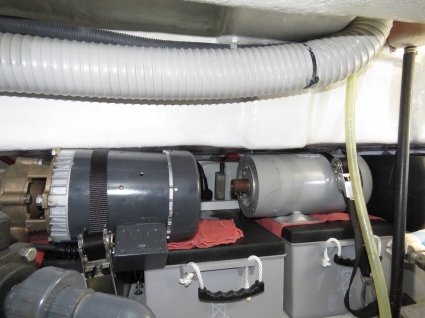
|
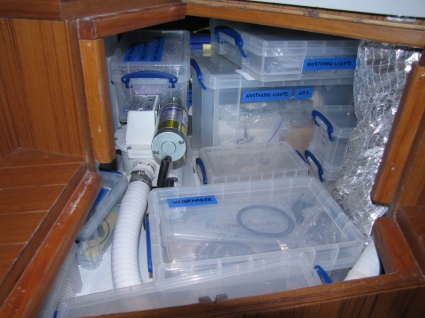
|
The final challenge in managing spare parts is knowing what is on hand and finding a part when needed. We have an endless number of parts stowed in bilges, lockers and random spaces throughout the boat. Spending time tearing the boat apart looking for a vital spare that you know have but just can’t find is frustrating. To track our spares, we use a simple Excel spreadsheet as shown below.
For each item stowed, we list at minimum a description and a location. Optionally we include quantity, type, category, PAE part number, vendor and part number, manufacturer and part number, and additional notes that typically provide more details on the actual location. For example, the yellow highlighted row below indicates we have two Hirschmann Type DIN Connectors on hand in the Hydraulics category, purchased through ABT, manufactured by Rexroth and stowed in a 1.5L bin in the bilge at the master stateroom door. (Click image for a larger view.)
We enable filtering on the spreadsheet to filter select rows that match a certain value. This helps us understand what parts we have on had of a particular type or category at a glance and can also help in locating an item by location or even by vendor or manufacturer. In the example below, we have filtered on the category ‘BBQ’ and it shows a list of the various parts we have on hand for our barbecue.
The small red symbols showing in the upper right of some cells are comments. We optionally add comments to provide more detail on a particular entry. In the example below, we have filtered on type ‘Zinc’ and are displaying the two comments for quantity and description on the main prop zinc. The quantity comment indicates we last inventoried that item on January, 2018 and the description comment indicates we have one installed on the boat with a link to where we’ve purchased it.
Our full inventory is at http://mvdirona.com/blog/content/binary/Dirona_Spares_Inventory.xlsx. We put a lot more than just spare parts in the inventory—we try to include anything we’ve stashed away in the boat somewhere and might not remember where it is. And sometimes we keep an item in the inventory with a quantity of zero to remind ourselves that we no longer have it in stock and it should be replenished or to track a part number.
No matter what system you use, the trick is keeping it up-to-date, so you really want a system you find natural and easy to use. The greater the overhead in tracking the parts, the less likely you are to keep it current. Some commercial offerings also combine a maintenance log application with a parts inventory. We use a separate Excel spreadsheet to track scheduled maintenance.
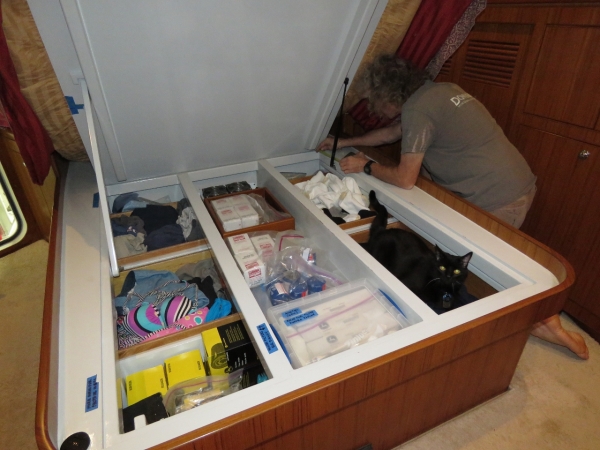
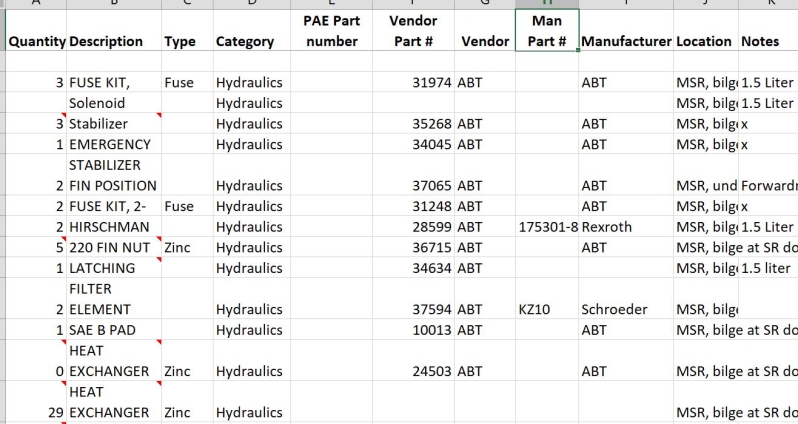

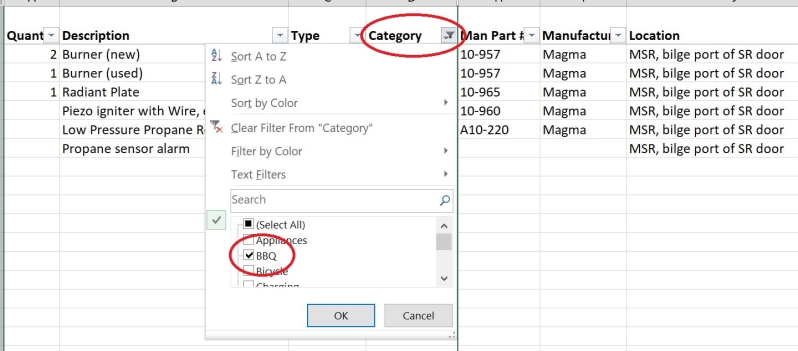
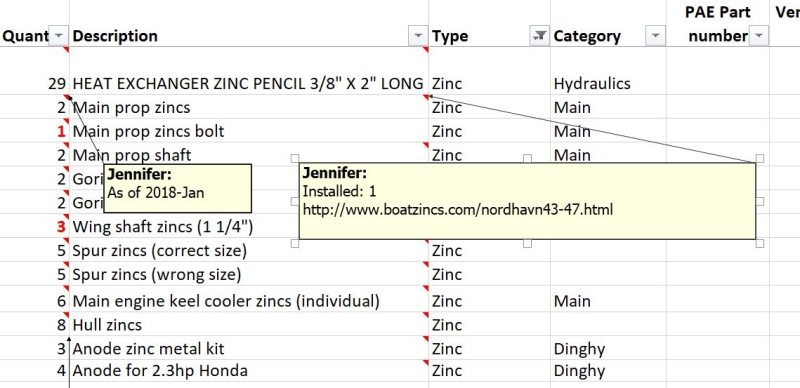
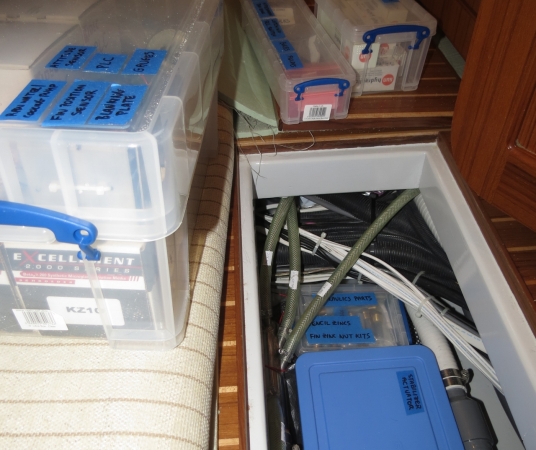
James and Jennifer:
The photo at the head of your “Managing Spares” section: https://mvdirona.com/2018/02/managing-spares/ shows a gas support for the bed. Would you please tell me the size and length? Thanks, Ron
In the picture you can only clearly see a single gas strut but there is one on each side. They are 120 lbs gas struts with 11.8″ compressed length and 19.7″ extended length and they currently cost $18.52 each on Amazon:https://www.amazon.com/gp/product/B007MUY656.
James, thank you. Ordering today.
Ron
I love the spreadsheet. I do the same. Thanks for the article. Enjoy london.
Impressed that you have a spare cat in there as well.
You can’t be too careful when cruising 100s and sometimes 1000s of miles from civilization :-).
That’s really a comprehensive list, I notice you even have a spare cat :)
You’re right Steve! Whenever I look into a dark little crevice, there are almost always two big yellow eyes looking back! We must have a dozen spare Spitfires :-).
You sure it isn’t just the one feline, using his innate ability (inherited from a rather unfortunate critter that hung around Schroedinger) to boogie around inconvenient corners in space-time (such as ahead to the welcome-home meal next Tuesday)? :)
I think Terry Pratchett was (one of) the first to articulate this hypothesis in The Unadulterated Cat.
If there is trouble to be had, Spitfire is usually the first there :-).
A very comprehensive inventory! A few questions if I may::
1 Do the extra spares add much (or significant) weight? Or is it irrelevant compared with fuel and water?
2 Do you operate a similar system for food supplies – quantities and location?
3 Re fire prevention/extinguishers what is your approach? I have recently come across the Fire Stryker fire inhibitor as an alternative to conventional fire extinguishers. I have noticed this is used by some in the 4×4 overland community because it does not need maintenance, is easy to store and has a long shelf life. Are you familiar with and have an opinion on this product?
David asked:
1 Do the extra spares add much (or significant) weight? Or is it irrelevant compared with fuel and water?
[jrh]Yes, all the spares certainly add material weight to the boat.
2 Do you operate a similar system for food supplies – quantities and location?
[jrh]We operate the boat the same way we ran our house except rather than shopping weekly we might show every 2 weeks and, at times, not for 7 to 8 weeks. We have a list that we add to between shopping stops and then pick that up when we get to the next store very much the same as you would with a home.
3 Re fire prevention/extinguishers what is your approach? I have recently come across the Fire Stryker fire inhibitor as an alternative to conventional fire extinguishers. I have noticed this is used by some in the 4×4 overland community because it does not need maintenance, is easy to store and has a long shelf life. Are you familiar with and have an opinion on this product?
[jrh]We have a permanently installed fire extinguisher bottle in the engine room and a SeaFire system to shut down engines and cooling fans if the fire extinguisher triggers either manually or automatically. We have a similar SeaFire configuration in the Lax. In addition we have hand held extinguishers spread throughout the boat. As a last resort, we have a Honda crash pump with a high pressure fire fighting spray nozzle but we wouldn’t fight a fire with salt water in anything other than a last resort.
The FireStyker system looks like an interesting possible replacement for small fire extinguishers but it doesn’t look to be adequate at least in current sized offerings for full engine room fire fighting. Generally, when it comes to fire safety, I’m conservative and won’t use new approaches unless I see commercial boats using it, classification societies accepting it, and insurance companies approving it.
You make a god point about waiting for wider acceptance. I cannot see the Fire Stryker on any list if UK British Standard approved appliances. It is made in South Africa and seems to have a following in the car racing and off road community there. It looks as thought its effectiveness is limited to small fires which you can get to very quickly.
Hi David and James…i hadn’t heard of the fire stryker until I read it here…so had to look it up! Interesting device to say the least but agree with you both on waiting to see how it “turns” out. The stryker does look similar (in operation) to a device marketed in NA to the fire service for extinguishing chimney fires though… I think the suppression system on most vessels like Dirona are pretty elaborate and well proven, and although i’ve never been fortunate enough to see them in the marine setting, the clean agent systems are about as good as you can get, not only when it comes to fast acting but particularly reduced damage. There’s another system out there that could prove useful to someone with a smaller vessel or one that doesn’t have a built in suppression system, i’m by no means a sales person for them but have seen them in action and can see one working tremendously in a closed compartment like an engine room. http://dspa.nl
Thanks again for sharing all you do, very educational!!!
Thanks for the pointer to dspa.nl Mark. I hadn’t seen their product before.